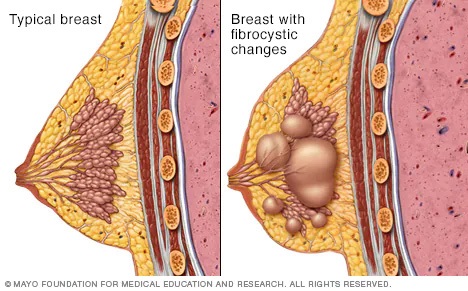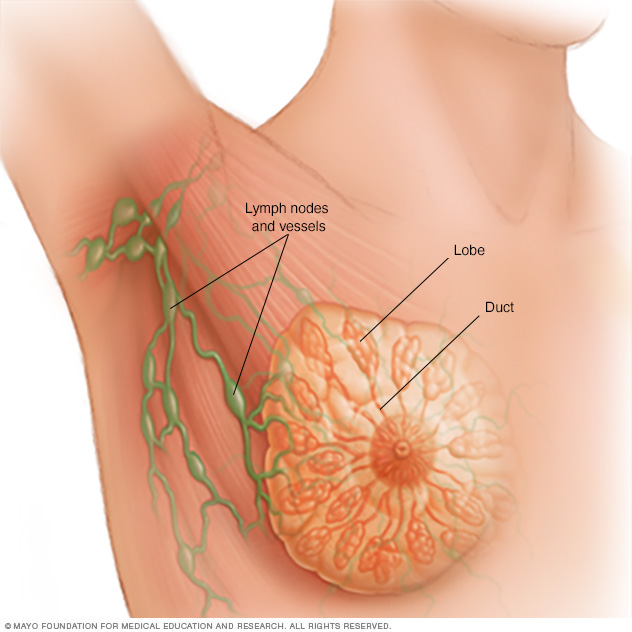Fibrocystic breasts
![]() November, 20th, 2024
November, 20th, 2024
Benefit Summary
Learn about this condition that’s common in women, including symptoms, possible causes and testing to determine when breast cysts might need treatment.
Overview
, Overview, ,
Fibrocystic breasts are composed of tissue that feels lumpy or ropelike in texture. Doctors call this nodular or glandular breast tissue.
It’s not at all uncommon to have fibrocystic breasts or experience fibrocystic breast changes. In fact, medical professionals have stopped using the term “fibrocystic breast disease” and now simply refer to “fibrocystic breasts” or “fibrocystic breast changes” because having fibrocystic breasts isn’t a disease. Breast changes that fluctuate with the menstrual cycle and have a ropelike texture are considered normal.
Fibrocystic breast changes don’t always cause symptoms. Some people experience breast pain, tenderness and lumpiness — especially in the upper, outer area of the breasts. Breast symptoms tend to be most bothersome just before menstruation and get better afterward. Simple self-care measures can usually relieve discomfort associated with fibrocystic breasts.

Fibrocystic breast changes lead to the development of fluid-filled round or oval sacs, called cysts. The cysts can make breasts feel tender, lumpy or ropy. They feel distinct from other breast tissue.
Fibrocystic breast changes Symptoms
Signs and symptoms of fibrocystic breasts may include:
- Breast lumps or areas of thickening that tend to blend into the surrounding breast tissue
- Generalized breast pain or tenderness or discomfort that involves the upper outer part of the breast
- Breast nodules or lumpy tissue change in size with the menstrual cycle
- Green or dark brown nonbloody nipple discharge that tends to leak without pressure or squeezing
- Breast changes that are similar in both breasts
- Monthly increase in breast pain or lumpiness from midcycle (ovulation) to just before your period and then gets better once your period starts
Fibrocystic breast changes occur most often between 30 and 50 years of age. These changes happen rarely after menopause unless you’re taking hormone replacement medicine such as estrogen or progesterone.
When to see a doctor
Most fibrocystic breast changes are normal. However, make an appointment with your doctor if:
- You find a new or persistent breast lump or area of prominent thickening or firmness of the breast tissue
- You have specific areas of continuous or worsening breast pain
- Breast changes persist after your period
- Your doctor evaluated a breast lump but now it seems to be bigger or otherwise changed
Causes
The exact cause of fibrocystic breast changes isn’t known, but experts suspect that reproductive hormones — especially estrogen — play a role.
Fluctuating hormone levels during the menstrual cycle can cause breast discomfort and areas of lumpy breast tissue that feel tender, sore and swollen. Fibrocystic breast changes tend to be more bothersome before your menstrual period and ease up after your period begins.
When examined under a microscope, fibrocystic breast tissue includes distinct components such as:
- Fluid-filled round or oval sacs (cysts)
- A prominence of scar-like fibrous tissue (fibrosis)
- Overgrowth of cells (hyperplasia) lining the milk ducts or milk-producing tissues (lobules) of the breast
- Enlarged breast lobules (adenosis)

Each breast contains 15 to 20 lobes of glandular tissue, arranged like the petals of a daisy. The lobes are further divided into smaller lobules that produce milk for breastfeeding. Small tubes, called ducts, conduct the milk to a reservoir that lies just beneath the nipple.
Breast anatomy Complications
Having fibrocystic breasts doesn’t increase your risk of breast cancer.
Diagnosis
Tests to evaluate your condition may include:
-
Clinical breast exam. Your doctor feels (palpates) your breasts and the lymph nodes located in your lower neck and underarm area checking for unusual breast tissue. If the breast exam — along with your medical history — suggests you have normal breast changes, you may not need additional tests.
But if your doctor finds a new lump or suspicious breast tissue, you may need to come back a few weeks later, after your period, for another clinical breast exam. If the changes persist or the breast exam is concerning, you may need additional tests, such as a diagnostic mammogram or ultrasound.
- Mammogram. If your doctor detects a breast lump or prominent thickening in your breast tissue, you need a diagnostic mammogram — an X-ray exam that focuses on a specific area of concern in your breast. The radiologist closely examines the area of concern when interpreting the mammogram.
- Ultrasound. An ultrasound uses sound waves to produce images of your breasts and is often performed along with a mammogram. If you’re younger than age 30, you might have an ultrasound instead of a mammogram. Ultrasound is better for evaluating a younger woman’s dense breast tissue — tissue tightly packed with lobules, ducts and connective tissue (stroma). Ultrasound can also help your doctor distinguish between fluid-filled cysts and solid masses.
- Fine-needle aspiration. For a breast lump that feels a lot like a cyst, your doctor may try fine-needle aspiration to see if fluid can be withdrawn from the lump. This helpful procedure can be done in the office. A fine-needle aspiration may collapse the cyst and resolve discomfort.
-
Breast biopsy. If a diagnostic mammogram and ultrasound are normal, but your doctor still has concerns about a breast lump, you may be referred to a breast surgeon to determine whether you need a surgical breast biopsy.
A breast biopsy is a procedure to remove a small sample of breast tissue for microscopic analysis. If a suspicious area is detected during an imaging exam, your radiologist may recommend an ultrasound-guided breast biopsy or a sterotactic biopsy, which uses mammography to pinpoint the exact location for the biopsy.
It’s important to report any new or persistent breast changes to your doctor, even if you’ve had a normal mammogram within the last year. You may need a diagnostic mammogram or ultrasound to evaluate the changes.

During fine-needle aspiration, a special needle is inserted into a breast lump, and any fluid is removed (aspirated). Ultrasound — a procedure that uses sound waves to create images of your breast on a monitor — might be used to help place the needle.

During fine-needle aspiration, a special needle is inserted into a breast lump, and any fluid is removed (aspirated). Ultrasound — a procedure that uses sound waves to create images of your breast on a monitor — might be used to help place the needle.
Fine-needle aspiration Treatment
If you don’t experience symptoms, or your symptoms are mild, no treatment is needed for fibrocystic breasts. Severe pain or large, painful cysts associated with fibrocystic breasts may warrant treatment.
Treatment options for breast cysts include:
- Fine-needle aspiration. Your doctor uses a hair-thin needle to drain the fluid from the cyst. Removing fluid confirms that the lump is a breast cyst and, in effect, collapses it, relieving associated discomfort.
- Surgical excision. Rarely, surgery may be needed to remove a persistent cyst-like lump that doesn’t resolve after repeated aspiration and careful monitoring or has features that concern your doctor during a clinical exam.
Examples of treatment options for breast pain include:
- Over-the-counter pain relievers, such as acetaminophen (Tylenol, others) or nonsteroidal anti-inflammatory drugs (NSAIDs), such as ibuprofen (Advil, Motrin IB, others) or prescription medication
- Oral contraceptives, which lower the levels of cycle-related hormones linked to fibrocystic breast changes
Lifestyle and home remedies
You might find relief from symptoms of fibrocystic breasts through one of these home remedies:
- Wear a firm support bra, fitted by a professional, if possible.
- Wear a sports bra during exercise and while sleeping, especially when your breasts are extra sensitive.
- Limit or avoid caffeine, a dietary change many people report as helpful, although medical studies of caffeine’s effect on breast pain and other premenstrual symptoms have been inconclusive.
- Eat less fat, which may decrease breast pain or discomfort associated with fibrocystic breasts.
- Reduce or stop taking hormone therapy if you’re postmenopausal — but be sure to talk to your doctor before making any change in your prescription medications.
- Use a heating pad or warm water bottle to relieve your discomfort.
Alternative medicine
Vitamins and dietary supplements may lessen breast pain symptoms and severity for some people. Ask your doctor if one of these might help you — and ask about doses and any possible side effects:
- Evening primrose oil. This supplement may change the balance of fatty acids in your cells, which may reduce breast pain.
-
Vitamin E. Early studies showed a possible beneficial effect of vitamin E on breast pain in people who experience breast pain that fluctuates during the menstrual cycle. In one study, 200 international units (IU) of vitamin E taken twice daily for two months improved symptoms. There was no additional benefit after four months.
For people older than 18 years, pregnant and breastfeeding, the maximum dose of vitamin E is 1,000 milligrams daily (or 1,500 IU).
If you try a supplement for breast pain, stop taking it if you don’t notice any improvement in your breast pain after a few months. Try just one supplement at a time so that you can clearly determine which one helps alleviate the pain — or not.
Preparing for an appointment
You’re likely to start by seeing your family doctor, nurse practitioner or physician assistant. In some cases, based on a clinical breast exam or findings on an imaging test, you may be referred to a breast-health specialist.
The initial evaluation focuses on your medical history. Your health care provider will want to discuss your symptoms, their relation to your menstrual cycle and any other relevant information.
What you can do
To prepare for your appointment, make a list of:
- All your symptoms, even if they seem unrelated to the reason for your appointment
- Key personal information, including the dates and results of any prior mammograms
- All medications, vitamins, herbs and supplements that you take
- Questions to ask your doctor, listing them from most important to least important in case time runs out
Basic questions to ask your doctor include:
- What’s causing my symptoms?
- Does my condition increase my risk of breast cancer?
- What kinds of tests will I need?
- What treatment is likely to work best?
- What are the alternatives to the primary approach that you’re suggesting?
- Are there any restrictions I’ll need to follow?
- Are there any printed materials that I can have? What websites do you recommend?
Don’t hesitate to ask questions anytime you don’t understand something.
What to expect from your doctor
Your doctor may ask you questions, such as:
- What are your symptoms and how long have you had them?
- Do you experience any breast pain? If so, what is the severity of your pain?
- Do your symptoms occur in one or both breasts?
- When did you have your last mammogram?
- Have you ever had breast cancer or precancerous breast lesions?
- Do you have a family history of cancer?
© 1998-2025 Mayo Foundation for Medical Education and Research (MFMER). All rights reserved. Terms of Use



